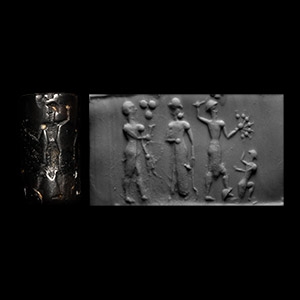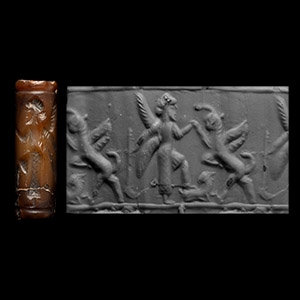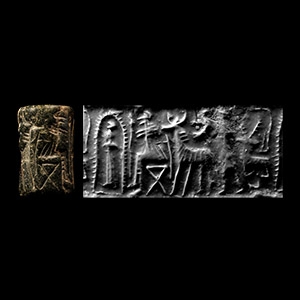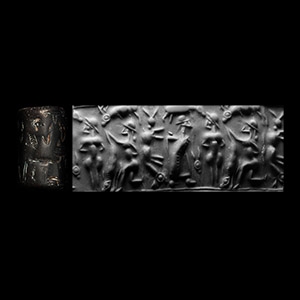With combat scene depicting two rearing gryphons flanking a standing bearded figure; supplied with a museum-quality impression. 5.43 grams, 20.53 mm
From the 'S' collection, acquired 1970-1990s.
The collection was seen and studied by W.G. Lambert, late Professor of Assyriology at the University of Birmingham, 1970-1993.)
This lot has been cleared against the Art Loss Register database, and is accompanied by an illustrated lot declaration signed by the Head of the Antiquities Department, Dr Raffaele D'Amato.
Cylinder with cord and bead handles; accompanied by a copy of an old scholarly note, typed and signed by W.G. Lambert, late Professor of Assyriology, University of Birmingham, 1970-1993, which states: 'Cylinder seal of soft black stone, 18 x 11 mm., condition good. Two registers divided by fine decorative band between rules; above: seven human heads and twig(?); below: three small quadrupeds with long ears. Syrian, c. 1900-1800 B.C.'; supplied with a museum-quality impression. 5.23 grams, 18 mm
UK private collection, acquired 1980-1983.
Accompanied by a copy of a scholarly note, typed and signed by Professor Wilfrid George Lambert in November 1988.
This lot has been cleared against the Art Loss Register database, and is accompanied by an illustrated lot declaration signed by the Head of the Antiquities Department, Dr Raffaele D'Amato.
Gilgamesh Killing Humbaba
Sold for (Inc. bp): £5,720
Representing a god with horned helmet, half animal and half man, standing on the left and holding a staff, near him the hero Gilgamesh killing Humbaba, and the hero Enkindu killing the celestial bull, followed by a mythological divinity depicted as half animal and half human; supplied with a museum-quality impression. 27 grams, 33 mm
Acquired in the mid 1980s-1990s.
Private collection, Switzerland, thence by descent.
Private collection, since the late 1990s.
This lot has been checked against the Interpol Database of stolen works of art and is accompanied by a search certificate number no.12577-232112.
This lot has been cleared against the Art Loss Register database, and is accompanied by an illustrated lot declaration signed by the Head of the Antiquities Department, Dr Raffaele D'Amato.
Cf. similar seal in Weber, O., Der Alte Orient, II volumes, Leipzig, 1920, no.15, 206.
King Sargon of Akkad created political unity when he seized control of Mesopotamia, and carvings on seals from the time demonstrate his success by portraying the power the Akkadian gods had to legitimize both their domain and their rulers. Religious scenes on cylinder seals detail the spiritual beliefs and practices of the time. The deeply intertwined relationship between religion and state power in Akkad is also present in the decorations of some cylinder seals. Here the hero Gilgamesh, embodying the strength of royal power, kills the monster Humbaba, as the king of Akkad kills his enemies.
Cylinder with cord and bead handles; accompanied by a copy of an old scholarly note, typed and signed by W.G. Lambert, late Professor of Assyriology, University of Birmingham, 1970-1993, which states: 'Description of Cylinder Seal of Red Jasper, 28.5 x 11.5 mm. Row of five figures, four standing, one apparently sitting, all with raised hand or hands; dots fill vacant spaces. This is a very rare type of cylinder, from the Levant c. 1200-900 B.C. the cutting is crude, but the impression of an enthusiastic throng is made clear. Though one can only guess, probably this is a religious celebration. The design is enclosed within upper and lower rules. the condition is good.'; supplied with a museum-quality impression. 6.74 grams, 23 mm
UK private collection, acquired 1980-1983.
Accompanied by a copy of a scholarly note, typed and signed by Professor Wilfrid George Lambert in October 1987.
This lot has been cleared against the Art Loss Register database, and is accompanied by an illustrated lot declaration signed by the Head of the Antiquities Department, Dr Raffaele D'Amato.
Sold for (Inc. bp): £2,340
Accompanied by a copy of an old scholarly note, typed and signed by W.G. Lambert, late Professor of Assyriology, University of Birmingham, 1970-1993, which states: ' Cylinder seal of black stone, 45 x 20 mm., condition fine. This seal shows three walking figures in a row, to be identified as gods from their headdresses. They are all clad in the same garb: long robes reaching the ankles, with a fringe reaching from the shoulder to the bottom, and another one around the bottom. The first one carried two rodents by their tails in one hand and holds a small scimitar in the other. The middle one holds up a twig of vegetation in one hand and a short rod in the other. The rear deity holds a twig in each hand, with (apparently) a string falling from each hand to the ground. There is a rodent sideways filling space between the second and last gods, and for a terminal there is a lozenge, a horned animal with front and rear legs close together, and a simple cross. This is a rare seal from west Iran, dating to c. 1200-1000 B.C. The twig as a divine symbol is well known from seals of this period excavated at Susa and Choga Zanbil, and other details are paralleled, such as the angular depiction of the hands holding the various objects.'; supplied with a museum-quality impression. 23.9 grams, 45 mm
From the private collection of a North American lady, formed 1970s-early 1990s, with collection reference no.P27.
Accompanied by a copy of a scholarly note, typed and signed by Professor Wilfrid George Lambert dated January 1990.
This lot has been cleared against the Art Loss Register database, and is accompanied by an illustrated lot declaration signed by the Head of the Antiquities Department, Dr Raffaele D'Amato.
Cylinder with cord and bead handles; accompanied by a copy of an old scholarly note, typed and signed by W.G. Lambert, late Professor of Assyriology, University of Birmingham, 1970-1993, which states: 'Description of Cylinder Seal of Chalcedony with white surface, 23 x 11 mm. Standing deity dressed in long robe, with one leg projecting, holding the front paw on either side of a horned animal standing on hind legs; diamond shape between the legs of one animal; lunar crescent above fish for terminal. Late Assyrian drilled style, c. 800-700 B.C. Condition: fine, save for one small harmless chip.'; supplied with a museum-quality impression. 6.19 grams, 22 mm
UK private collection, acquired 1980-1983.
Accompanied by a copy of a scholarly note, typed and signed by Professor Wilfrid George Lambert in November 1987.
This lot has been cleared against the Art Loss Register database, and is accompanied by an illustrated lot declaration signed by the Head of the Antiquities Department, Dr Raffaele D'Amato.
Sold for (Inc. bp): £2,340
Slightly waisted with bronze caps, accompanied by a handwritten scholarly note signed by W.G. Lambert, late Professor of Assyriology, University of Birmingham, 1970-1993, which states: 'Cylinder seal of green stone with bronze caps; 34 x 16 mm. overall. Matching pair of contestants: nude hero and rampant lion. Inscription: name of ancient owner, but secondary, cannot be read. Akkadian, c. 2300-2200 B.C. Condition fine.'; supplied with a museum-quality impression. 12.23 grams, 34 mm
From a London, UK, collection, 1980s.
Ex North American collection.
Accompanied by a scholarly note by Professor Wilfrid George Lambert.
This lot has been cleared against the Art Loss Register database, and is accompanied by an illustrated lot declaration signed by the Head of the Antiquities Department, Dr Raffaele D'Amato.
Cylinder with cord and bead handles; accompanied by a copy of an old scholarly note, typed and signed by W.G. Lambert, late Professor of Assyriology, University of Birmingham, 1970-1993, which states: 'Cylinder Seal of Hematite, 26.5 x 15 mm. The design consists of two pairs of figures. The one consists of two standing figures: the one on the right is a deity, whether male or female is not clear, wearing a smooth hat and a long robe open at the front from which one leg projects. One hand is held at the waist, the other grasps a scimitar. Facing is a nude male figure holding a small bucket in one hand and a small vessel in the other, apparently to sprinkle water from the bucket. It is not known if this figures is meant as a human priest or a minor god. Between this pair in the sky are three dots. The other pair consists of a victor wearing dress that only reaches the knees. His feet are apart, and his one raised hand holds a weapon, while in the other is a seven-fold item, either meant as a revolving weapon, or as a 'multiple club'. (Some have suggested that it is a sling.) The victor's victim is kneeling, and turns back to face his oppressor and plead with raised arm. The victor's one foot rests on the leg of the victim so that he cannot escape. The identity of this victor is so far unknown. This seal is Old Babylonian, from southern Iraq or a neighbouring area, and dates from c. 1900 - 1700 B.C. Though there is some wear and corrosion, the whole design is clear.'; supplied with a museum-quality impression. 15.9 grams, 26 mm
UK private collection, acquired 1980-1983.
Accompanied by a copy of a scholarly note, typed and signed by Professor Wilfrid George Lambert in July 1990.
This lot has been cleared against the Art Loss Register database, and is accompanied by an illustrated lot declaration signed by the Head of the Antiquities Department, Dr Raffaele D'Amato.
With frieze depicting a combat scene of a leaping gryphon and winged god advancing; repaired and supplied with a museum-quality impression. 5.17 grams, 31 mm
From the 'S' collection, acquired 1970-1990s.
The collection was seen and studied by W.G. Lambert, late Professor of Assyriology at the University of Birmingham, 1970-1993.
This lot has been cleared against the Art Loss Register database, and is accompanied by an illustrated lot declaration signed by the Head of the Antiquities Department, Dr Raffaele D'Amato.
Sold for (Inc. bp): £1,105
Cylinder with cord and bead handles; accompanied by a copy of an old scholarly note, typed and signed by W.G. Lambert, late Professor of Assyriology, University of Birmingham, 1970-1993, which states: 'Cylinder of dark-green stone, 39 x 25 mm., some incrustation which could be removed; condition good. Figure ( god? ) under notched arch, seated figure to right, leaning forward and holding spear; two distinct horned animals with standing figure between them, bird. From North Syria or Anatolia, c. 2000 B.C.'; supplied with a museum-quality impression. 48.5 grams, 39 mm
UK private collection, acquired 1980-1983.
Accompanied by a copy of a scholarly note, typed and signed by Professor Wilfrid George Lambert in November 1988.
This lot has been cleared against the Art Loss Register database, and is accompanied by an illustrated lot declaration signed by the Head of the Antiquities Department, Dr Raffaele D'Amato.
Requesting Access to the Palace
Sold for (Inc. bp): £2,600
Accompanied by a copy of an old scholarly note, typed and signed by W.G. Lambert, late Professor of Assyriology, University of Birmingham, 1970-1993, which states: 'Cylinder Seal of Glass 47 x 15 mm. The main scene in the design shows a seated god on the right wearing a long robe with bottom fringe, sitting on a stool with crossing struts and holding in one hand a situla. Before him stands a servant similarly dressed and extending one hand. Between the two figures is a locust in big size and in the upper parts is a symbol. Above this scene is a band with three recumbent quadrupeds. The remainder of the space is devoted to a three-line cuneiform inscription:
garna4kišib ne May the owner of this seal
ina é-gal DU have free access to the palace
NI Ni APKIN KA
This is a Middle Elamite seal, c. 1400-1100 B.C. The design an inscription are based on Cassite-period Babylonian seals, but with Elamite rendering. This is a large seal and though the ends are chipped, it is otherwise in very good condition for ancient glass. Indeed, it is in such excellent state that one asks if it is not volcanic glass, namely obsidian. However, the pitted surface favours man-made glass, but in unusually good condition.'; a more comprehensive and up-to-date translation is:
ki dingir ti-la Life is the gift of god.
ina é-DU.DU (May he (seal owner)) have free access to the palace,
i3-li2 APKIN KA I beseech you, my god.
; supplied with a museum-quality impression. 16.60 grams, 47 mm
Acquired from Christie's, New York, USA.
From the private collection of a North American lady, formed 1970s-early 1990s, with collection reference no.P51.
Accompanied by a copy of a scholarly note, typed and signed by Professor Wilfrid George Lambert.
This lot has been checked against the Interpol Database of stolen works of art and is accompanied by a search certificate number no.12693-236341.
This lot has been cleared against the Art Loss Register database, and is accompanied by an illustrated lot declaration signed by the Head of the Antiquities Department, Dr Raffaele D'Amato.
Cylinder with cord and bead handles; accompanied by a copy of an old scholarly note, typed and signed by W.G. Lambert, late Professor of Assyriology, University of Birmingham, 1970-1993, which states: 'Cylinder Seal of Hematite, 19 x 11.5 mm. The major part of the design consist of a seated figure, no doubt a god, holding up one hand in greeting to a standing figure, meant as a human worshipper, who similarly hold up one hand. Between them is a table with elegant legs on which rests a pile of breads. Above this is a motif probably intended as a stylized bull's head. The minor part of the design consists of a row of five walking men, the first raising one hand, the last carrying a crook over his shoulder. This is a Syrian seal, c. 1900-1700 B.C. and though the stone is somewhat worn, the design is fully clear.'; supplied with a museum-quality impression. 7.5 grams, 18 mm
UK private collection, acquired 1980-1983.
Accompanied by a copy of a scholarly note, typed and signed by Professor Wilfrid George Lambert in August 1991.
This lot has been cleared against the Art Loss Register database, and is accompanied by an illustrated lot declaration signed by the Head of the Antiquities Department, Dr Raffaele D'Amato.

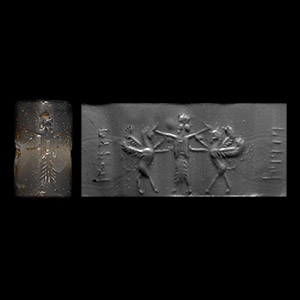
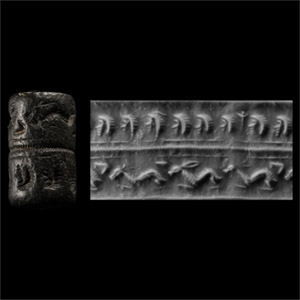
.jpg)
.jpg)
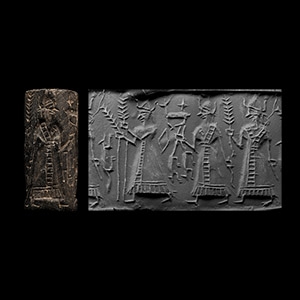

.jpg)
